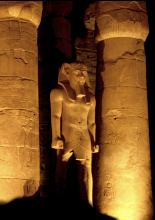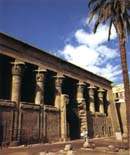|
Luxor/Karnak/Thebes
Luxor has often been called the worlds greatest open air museum, as indeed it is and much
more. The number and preservation of the monuments in the Luxor area are unparalleled
anywhere else in the world that know of. Actually, what most people think of as Luxor is
really three different areas, consisting of the City of Luxor on the East side of the Nile, the town
of Karnak just north of Luxor and Thebes, which the ancient Egyptians called Waset, which is
on the west side of the Nile across from Luxor.
 To say that the Luxor area is a major attraction for tourists in Egypt would be an understatement. It has been a tourist destination since the beginning of tourism. Even in ancient times, during the late To say that the Luxor area is a major attraction for tourists in Egypt would be an understatement. It has been a tourist destination since the beginning of tourism. Even in ancient times, during the late
Dynasties of the Greek and Roman periods, the area drew tourists, and has been doing so ever
since. Today Luxor is well equipped to accommodate tourists with many hotels and in general
a tourist industry ready and willing to serve the people from many countries that descend on
this area of the Nile Valley every year.
Within Luxor, there are only three main streets consisting of Sharia al-Mahatta, Sharia al-Karnak and
the Corniched, next to the Nile. The street in front of the train station is Sharia al-Mahatta and runs away from the Nile where it meets the gardens of Luxor Temple. Sharia al-Karnak, or Maabad al-Karnak which means Karnak Temple Street runs along the Nile from Luxor Temple to Karnak Temple. However, Sharia al-Karnak is known as Sharia al-Markaz where it meets Sharia al-Mahatta
street, and to the south around the temple it is known as Sharia al-Lokanda. Along this street
one will find the colorful signs of restaurants and cafes, as well as bazaars where the usual
variety of Egyptian souvenirs can be found. Of interest is the alabaster, which is plentiful along the west bank and miled not far from here. Also look for the clay pots used by the locals for
cooking, which are more unusual.
 Luxor today is a city of some 150,000 people and is governed by special statues that allow it more autonomy then other political areas of Egypt. One thing you might notice is that various government and other buildings confirm to an 'ancient' building code. Particularly, the National Luxor today is a city of some 150,000 people and is governed by special statues that allow it more autonomy then other political areas of Egypt. One thing you might notice is that various government and other buildings confirm to an 'ancient' building code. Particularly, the National
bank of Egypt (located near the winter palace), the spa south of the police station, and the railway station are all designed to appear as pharaonic constructs. All of this occurred after the Egyptianization of the modern town resulting mostly from the mania that resulted from Howard Carter's discovery of the Tomb of Tutankhamun. As one might think, the city has all the amenities tourists might expect, including a variety of hotels, bars, nightclubs and restaurants.
In Luxor proper on the East Bank, one of the first stops must be the Temple of Luxor built by Amenophis III. Head south on Sharia al-Karnak to reach the temple, which was connected to the Karnak Temple via a long stone processional street called a dromos. The dromos (Pictur at right) was built by Nectanebo I, and originally was lined on either side by sphinxes. In front of the Luxor temple, the dromos is well preserved, and on the way to the entrance one passes by a Roman chapel of burnt brick dedicated to the god Serapis, which was built during the rule of Hadrian. There is a path that leads to the Nile side of the Temple where one enters the complex.
After leaving Luxor, head back to Sharia al-Karnak and go north towards Karnak. Down the
road, near the police station which is near the tomb is the oldest mosque in Luxor, the
El-Mekashkesh Mosque. It contains the remains of a 10th century Islamic saint who rumor
has it was a monk prior to converting to Islam. The mosque is a popular pilgrimage
destination. Here also is the Franciscan Church and its schools, one for boys and the other
girls. Beyond this lies a great Coptic basilica.
 |
At the Police station, head towards the Nile Corniche. Here, opposite the Mina Palace Hotel
you will find the Mummification Museum, which has most anything you would ever want to
know about mummificationís. From here, head north towards Karnak.
About halfway to Karnak, you will discover the Luxor Museum. (The image at left is a Block Statue of Iamu Negh from the Luxor Museum). It should certainly be visited if you plan a well rounded and educated experience. While this is a small museum, most of the relics are from the surrounding area
and provide considerable insight to the monuments you will visit.
From the Museum, head back to Sharia al-Karnak and continue north towards Karnak.After crossing a small bridge one will begin to see the excavated dromos off the road and running through a small village. A little further on you will pass the ruins of the Temple of Mut where another dromos leads to the gateway of the tenth pylon. The road finally arrives at the domed tombs of two saints, Sidi Ahmed and Sidi Ali, where a road leads past the Department of Antiquities leads to the main Temple of Karnak entrance. This road is built along a canal that once connected the Nile to the Temple. There was a dock in ancient times, but now all that is left is the quay and the raised dais. Just past that is a red brick Roman dock and past that two paved ramps led to the river bank. They are bordered by stone parapets, and were built during the rule of Taharqa.Past these is the Chapel of Achoris, which received the sacred boat of Amun when it was used in ceremonies.
To arrive at the entrance one follows the dromos with its crio-sphinxes. They have the head of a Ram and the body of a lion and are symbolic of the God Amun. Arriving at the temple, there is a statue of Ramesses II with his son between his feet.
To the right is a structure that has red steps, a red front colonnade and red brick walls. Inside there are pedestals. inscribed with the names of Roman emperors, that once held their statues. This was a Roman chapel dedicated to imperial worship. After leaving the Temple complex on the left is the
Franco-Egyptian Center which has managed the temple complex since 1967. Down on the shore of the Nile is the Centre National dl la Recherche Scientifque, or CNRS, which houses the French and the Chicago House, a project of the University of Chicago is near by.
After this, you will wish to take a boat trip over to the West bank. This trip had a special meaning to the Egyptians, for they were more crossing the way to the West and life, then to a necropolis. The Valley of the Kings is as good as any to try first, with tombs from the 18th and 19th Dynasties. Outside the Valley of the Kings, the road leads past Antef, named for the 11th Dynasty prices who were buried here. Some tombs can still be seen as one heads towards the Temple of Seti I. Most of what is left of Seti's Temple is the view. The court is entered by the ruined gate of a pylon The court has what is left of a palace on the south side. The road continues south passing Dra-Abu el-Naga necropolis.
The road eventually winds itself westward until reaching the Valley of Asasif. These are 25th
and 26th Dynasty tombs. At the end of of the Valley of Asasif at the foot of a cliff named Deir
el-Bahri is a spectacular complex of temples. The Temple of Mentuhetep I, Hatshepsut and
Thotmose II here must be seen. Much of the architecture here seems so very powerful against
the towering cliffs in the background. From here, the road continues past the remains of the
temples of Ramesses IV and Thutmose III, eventually reaching the Necropolis of Sheikh Abd
el-Qurna. This 18th Dynasty necropolis sits amidst houses where there are hundreds of
holes. And below here, one comes to the famous Ramesseum, built by Ramesses II, a huge
complex that took twenty years to complete.
As the road runs along past the remains of Thutmose IV, Merneptah, Ay and Horemheb's
Temples, it finally comes to the huge complex known as Medinet Habu, which is another of
Thebe's major attractions and a must see sight. The gate has square towers and appears
almost oriental. Behind the complex is the workmen's village called Deir el-Medina. Out in the
fields near here is the Colossi of Memnon, one of the major tourist attractions throughout time.
Southwest of Deir el-Medina is the Valley of the Queens, where queens of the 18th and 19th
Dynasties were buried.
From here, the road continues past the mudbrick remains of the Amenhotep III's palace called
Malkatta. There is a lake to the east and at the other end of that, a small Roman temple called
Deir Shelwit and built at the end of the 1st century.
|

